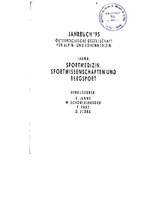Langfristige höhenanpassung in den Bolivianischen Anden
Abstract
SUMMARY.
The present report gives basic facts on geography, population and history of the Andean region of Bolivia. Based on research carried out at the Instituto Boliviano de Biología de Altura (I.B.B.A.), Universidad Mayor de San Andres, in La Paz, the main features of long term adaptation to high altitude either by birth and continous residence or early migration are reported. Altitude hypoxia has a small or no effect at all on longitudinal growth. Total lung capacity is increased mainly by increase of residual volume and secondly by increase of vital capacity. Highland Aymara have an accelerated growth of thorax dimensions and lung function as compared to high-altitude natives of European ancestry. Development of European girls born at high altitude is delayed by about 0.8 years, whereas growth and development of prepubertal boys of low socio-economic level is delayed by 2 years at high altitude as well as in the lowlands. Other features like blunted respiratory drive, increased diffusing capacity, increase of P5O, of pulmonary artery pressure and hemoglobin concentration are also described as well as the effect of high altitude hypoxia on the right ventricle in infants. With respect to work capacity expressed as maximal oxygen consumption (VO₂ max), a decrease of 11-15% is seen in children compared to similar sea level children. Adolescent boys of Aymara ancestry and of European ancestry have similar VO₂ max's. Finally, high altitude natives increase their VO₂ max less when inhaling additional O₂ than acclimatized sea level natives. With a training program used at lowland in lowland subjects, high altitude natives increase their V0₂ max in the same degree, additional oxygen does not bring a greater increase of V0₂ max. Maximal lactate concentrations are similar at high and low altitude, but high altitude natives trained in normoxia show a decreased buffer capacity.

